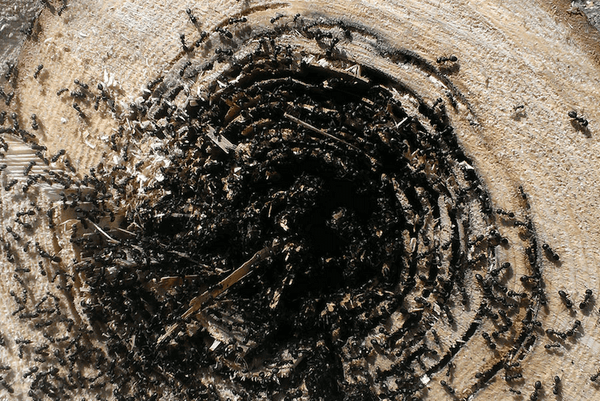Reading time: 1:39 minutes
Behaviors of carpenter ants:
Black carpenter ants, which regularly plague structures in Canada, are small insects that live mainly outdoors, but can easily penetrate inside homes to find food or to establish nests. satellites. These insects have a particular affinity for kitchens and places where meals are taken. They can gain access to bathrooms, roofs or basements by exploiting access points weakened by leaking pipes and moisture. They can also enter homes by using tree branches or shrubs that touch exterior walls. Once inside, they can dig nests in empty spaces in walls, attics, insulation, or even in crawl spaces. Although they are capable of digging through healthy wood, they prefer soft wood that has been damaged by water and heat, whether inside or outside homes. If you are faced with a carpenter ant infestation, it is important to act quickly to limit the damage and prevent new nests.
Damage caused by carpenter ants inside homes:
Carpenter ants can cause considerable damage to the structure of a home, including beams, trusses, supports and foundations. They build sophisticated tunnel systems by digging into wood, inside and outside houses, identifiable by the piles of sawdust at the entrance and exit of the tunnels. Homeowners can spot the large, wingless worker ants searching for food and returning to their colony to report their discovery. Although the presence of worker ants does not necessarily mean an infestation, it does indicate the possibility of an intrusion since it shows potential access points for these ant species.

What are carpenter ants attracted to?
Carpenter ants are particularly attracted to moisture and dead wood, which often causes them to invade homes and yards. To avoid an infestation of these insects, residents should regularly inspect their property for water leaks caused by damaged pipes or roofs and properly ventilate affected wooden structures. It is also recommended to reduce the amount of dead or decaying wood, logs and tree trunks on the property, and to prune branches and shrubs that touch the house. Indoors, it's important to clean up food spills quickly and put food away to avoid attracting carpenter ants. Finally, adequate ventilation will reduce excessive humidity in the air and prevent carpenter ant infestations.
What do carpenter ants do in winter?
As a cold-blooded insect, the carpenter ant adjusts its body temperature depending on its environment. In Canada's harsh winters, these ants are unable to generate enough heat to maintain physical activity, so they go into hibernation in their nests until warmer temperatures return in the spring. Although most carpenter ant colonies become dormant in winter, especially when exposed to outdoor elements, some indoor colonies can continue to be active year-round if provided with a sufficient heat source. .
Carpenter ant colonies active during the winter require a heat source close to their nest. Gaps in walls that are exposed to direct sunlight or warm air from heating systems often provide the heat needed to stimulate carpenter ant activity. Carpenter ants sheltering in heated indoor spaces often wait until nighttime to emerge and seek moisture in places such as baths, dishwashers, sinks and toilets. However, on sunny days, carpenter ants may explore other parts of the house. The presence of active carpenter ants in a home during the winter is a sign of an infestation.
To treat an active infestation, it is recommended to use effective products rather than large-scale products. Additionally, Online Exterminator can provide valuable advice and information via its call center and explanatory videos.

